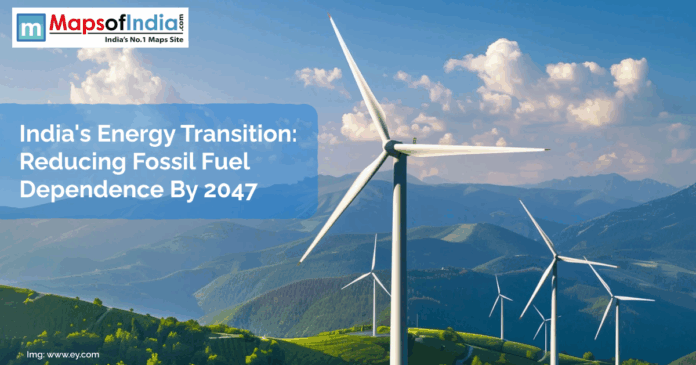Meeting energy needs sustainably and tackling climate change is both a crucial opportunity and a challenge for India, the world’s fastest-growing economy. But with a population of more than 1.4 billion and growing energy needs, the country must turn decisively away from reliance on fossil fuels. By 2047, the 100th anniversary of India’s independence, the country aims to become a global leader in clean energy. Realizing this ambitious target will require overcoming technological, economic, and policy challenges, as well as harnessing the opportunities afforded by renewable energy
India’s Energy Landscape: A Snapshot
India is the world’s third-largest energy consumer, after China and the United States. Some 75% of its energy consumption is sourced from fossil fuels, including coal, oil, and natural gas. India has a very coal-dependent economy with coal contributing to about 55% of its electricity generation. But with this dependence comes a heavy environmental price: India ranks third largest globally in greenhouse gas (GHG) emissions, with energy generation being a substantial contributor
India may continue to remain heavily powered by fossil fuels but is also making pains in the development of its renewable energy resources. As of 2023, the nation has an installed renewable energy capacity of more than 175 GW, with 70 GW of solar energy, 45 GW of wind energy and 10 GW of biomass. These figures underscore India’s ambition to move toward cleaner sources of energy.
The Vision for 2047
India’s energy transition roadmap is also in line with its international commitments as part of the Paris Agreement. The country plans to reach net zero carbon emissions by 2047, with interim targets that include achieving 500 GW of non-fossil fuel capacity by 2030, and 50% of its energy needs from renewable sources. India’s Vision by 2047 includes:
- Reducing CO2 emissions from existing, fuel-burning facilities for power generation.
- Scaling Up Renewable Energy Expand solar, wind, hydro and biomass energy generation to displace fossil fuel-based electricity generation.
- Investing in battery technology and other storage technologies to address the intermittency of renewables.
- Developing Decentralized Energy Systems for provisioning reliable and affordable access to energy for rural and remote areas through distributed energy resources.
- Speeding up the transition to electric vehicles (EVs) and clean industrial processes
Challenges in Reducing Fossil Fuel Dependence
- Economic Factors: Fossil fuels are cost-competitive and highly embedded in the Indian economy. Switching to renewables demands heavy capital investments in infrastructure, technology, and training.
- Energy Security: India imports around 85% of its crude oil and 50% of its natural gas needs. The challenge of lowering this dependence without ever running out of energy is by no means trivial.
- Technological Challenges: Although renewable energy technologies are maturing, challenges such as grid integration, energy storage, and efficiency are still major barriers.
- Structural and regulatory contexts: Transition to clean energy requires robust policies to encourage its adoption and manage the decline of fossil fuel industries
- Social Considerations: The coal sector employs millions, both directly and indirectly. Increased health risks in these communities as a result of coal mining and burning should be taken into account, and transitioning away from coal must bring along measures for upskilling the workforce and diversifying the economy in designated regions.
A Path Towards Sustainability
India boasts excellent potential for solar and wind energy due to its physical diversity. Because the country enjoys about 3,000 hours of sunshine a year, the potential for solar power is especially tempting.
India is a major destination for global investments in renewable energy. Set up at the initiative of India, the ISA is an alliance of over 120 countries, most of which are solar-rich countries, and aims to be a common platform to facilitate all solar technology deployment around the world with India at its centre. Regulations, incentive structures, and government policies can have a significant impact on energy efficiency and renewable technology adoption levels.
Energy efficiency programs such as the Perform, Achieve and Trade (PAT) scheme and the Unnat Jyoti by Affordable LEDs for All (UJALA) scheme have shown substantial energy savings. India is investing in green hydrogen as a clean alternative to existing fossil-fuel paths for industrial processes and transportation. The National Hydrogen Mission, which was launched in 2021 and which aims to make India a global manufacturing and export hub for hydrogen.
Public Policies and Initiatives
Several policies have been introduced by India’s government to speed up energy transition like:
- National Solar Mission: It was launched in 2010 and aims to provision a capacity of 280 GW of solar power generation by the year 2030.
- Faster Adoption and Manufacturing of (Hybrid &) Electric Vehicles (FAME): Facilitates EV adoption with incentives and infrastructure development.
- Promotion of Investment in Renewable Energy: 100% foreign direct investment (FDI) is allowed under the automatic route in renewable energy projects.
- National Electricity Policy (NEP): Universal electricity access and renewable integration to grid.
- Carbon Pricing and Trading: India will establish a trading system for carbon and link it to a national mechanism that rewards emissions cuts.
International Collaborations
International partnerships aid India’s energy transition:
- International Solar Alliance (ISA): Facilitates solar energy deployment among 121 member countries.
- U.S. and EU: Joint efforts on new clean energy technology, exchanging policies and financing.
- Bilateral Treaties: Adoption of treaties with countries such as Japan, Germany, and Australia to facilitate access to sophisticated technologies and capital.
The role of private sector and civil society
Mobilizing the private sector is key to scaling up renewable energy projects. Companies such as Tata Power, Adani Green Energy and ReNew Power are spearheading solar and wind deployment. Startups working on EVs, energy storage, and smart grids are innovation forces. NGOs and civil society act as consciousness raisers, advocates for policy change, and implementers of grass-roots initiatives for energy access and efficiency.
The Road Ahead
India’s energy transition is a necessity and a challenge. Though this presents challenges, the country’s commitment to sustainable development positions it as a potential leader in clean energy globally. In 2047 India can set an example for reconciling economic growth with environmental stewardship. Success will require:
- Working across sectors, states emerged and stakeholders for all.
- Supporting inventions and research to help make clean technologies cheap and widespread.
- The need to ensure vulnerable populations and regions are protected in the just transition.
- Climate change is a global challenge and India has a vital role to play in international forums.
India’s aspiration to be an energy repository if achieved will stand out a beacon as its energy transition in 2047 will play a pivotal role in addressing together with climate change in the world. The country’s capacity to further this shift will rely upon audacious policies, technological innovations and a common political will.




